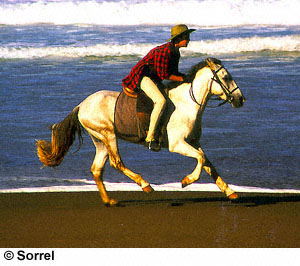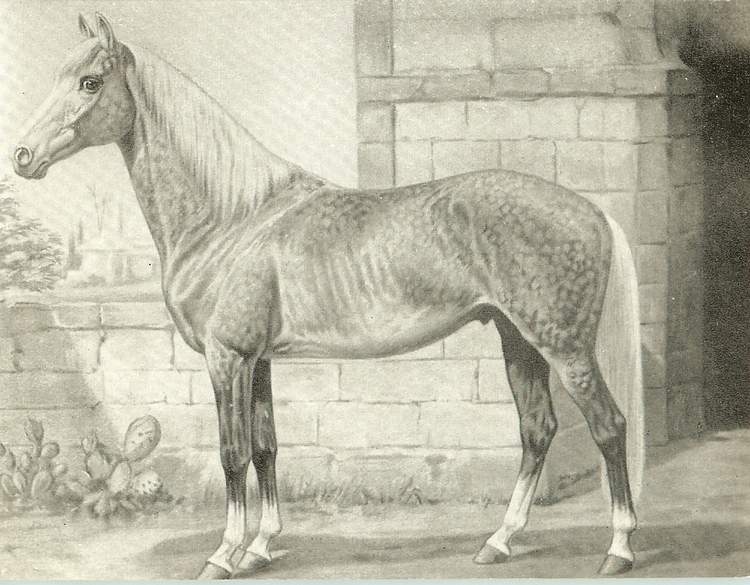

Barb


Introduction: This incredible breed is in danger of extinction. If you have any comments or suggestions, please click here. The picture on the above right is an old painting of a Barb, which I have not yet identified; the one on the left is probably a fairly recent photograph.
Names: Barb. I believe it is named for the Barbary coast. Sometimes referred to as the "Barbary horse" or "Berber horse," after its place of origin or the people that bred it. I will simply call it the Barb.
Origin: Comes
from North Africa. Usually associated with Morocco, although it really
comes from the geographical area of Barbary, which includes present-day Algeria,
Morocco, Tunisia, and Libya. Supposed part
descendants of the old Numidian horse, their origins are as obscure, and some
say the same, as those of the Arabian.
Many Barbs exported to England in days gone by were undoubtedly Arabians
bred in Barbary, and a "Barb" can also mean a horse from a
barbaric, foreign country. They arrived in Spain with the Muslim
invasions, had a great influence on the old Spanish Andalusians
and, through them, numerous Continental and South American
horses.
The history of the Barb runs parallel with that of the North
African Berber people who have contributed greatly to its development. The
breed was most probably introduced into Europe in the eighth century, at the
time of the Moorish invasion of Spain, where it gave rise to the Andalusian.
It has also been claimed, some say wrongly, that the Godolphin stallion (1724),
which made a decisive contribution to the creation of the English Thoroughbred,
was in fact a Barb and not an Arab
as some suggest. In the seventeenth century the Barb
was widely renowned throughout Europe, however, two centuries earlier in the
streets of Rome it had taken part in the "corse dei Berberi," the
famous Berber horse race of which Pope Paul II was the patron.
From The Empire of Equus: The typical light
riding horse of North Africa, which region was formerly known as the Barbary
States. Possibly an admixture of Arab and Moroccan or Algerian blood.
About the same size as the Arab, but with a less refined head and a lower-set
tail. Several strains of the breed exist in various parts of Africa.
Breeding: Today
the Barb is reared as a purebred only among the nomadic populations of North
Africa. Comparatively
few are without Arabian
blood, and the Libyan Barb is descended from
a cross of the two breeds, plus traces of others brought in by the frequent
migrations and invasions. Elsewhere the breed has
been subjected to crosses with the English Thoroughbred.
Barbs are also bred pure at a large stud at
Constantine in Algeria.
In the seventh century, when the Arabs invaded northern
Africa, imposing their language, religion and culture on the local Berber
peoples, the Barb was subjected to repeated crossings with Arab
horses. The animals produced were of such high
quality that they gradually substituted the original Barb, which consequently
went into a decline. Toward the mid-nineteenth century purebred Barbs had
become so rare that they could only be found among remote tribes in the
mountains and desert of Morocco. The true Barb therefore comes originally
from Barbary, a geographical area, corresponding to present-day Algeria,
Morocco, Tunisia, and Libya.
The Tuaregs, a fearsome nomadic tribe, were the only Berbers
successfully to defend their extensive territories from the Arab invasions,
consequently the Barb horses they bred remained uncontaminated by the Arab.
This proud people is renowned for the skill of its horsemen and the quality of
the horses used in its warring forays.
While I have found places in the United States where this
horse is now bred, it is still not very common in Western countries. The
following information about breeding and history of the breed is taken from a
fairly old source. It lists the breeding area as North Africa, with studs
in Algiers, at Oran and Constantine, and in Tunis, Sidi Tabet Stud. It
also states that the Barb originated from the ancient Numidian breed (Equus
caballus africanus), from which the Carthaginian horsemen obtained their
remounts during the Punic Wars. After the mass migration from Arabia,
there came a steady stream of Arabs to North Africa, so that the Barb became
increasingly nearer to the Arab type. (At this last remark, I cannot help
but add a fascinating bit of information I obtained from a source which I hope
someday to have in my possession. A fairly new book, more to do with
cavalry and warfare than horses in particular, nevertheless caught my attention
with a rather audacious-sounding statement that I almost wish were true!
It suggested, quite briefly, that "North Africa too had long been renowned
for its horses, and it was under Muslim rule that the tough, enduring barb was
crossed with the more refined and spirited eastern types to produce the famous
Arab breed." I leave that comment to the reader's judgement or
emotion, and will neither defend nor refute it at this point!)
Description: An athletic horse of the mesomorphic type. Strong, in spite of its small build and slim legs.
Action: Rather short stride in walk; really good trot; light gallop, not very long stride.
Body: Back short and straight. Chest wide and deep. Neck medium length to long, well-muscled, arched and well-carried. Shoulders flat, long, and sloping; sometimes steep. Quarters sloping. Withers high and prominent. Strong, vaulted loins. Pointed, narrow and sharply sloping croup.
Color: Usually bay, gray, black, brown or chestnut. Grey and white common.
Head: Rather long, with pronounced jaws and flared nostrils. Eyes lively. Profile straight or convex. Long, extended and clean Roman nose; strong cheeks.
Hooves: Small, and very hard, with hard, tough horn.
Legs: Hard, slender and solid, with broad joints. Very well-shaped with excellent, clearly marked hocks and tendons, the latter prominent and clearly defined. Cannons have been described by various sources as both short and long.
Size: 14 to 15 hands (1.45 to 1.55 meters). Usually not more than 15 hands high.
Tail: Low set and flowing, but not very well carried.
Temperament: Docile and courageous. Fiery temperament, reliable character.
Features: Can live on poor feed. Fast over short courses. Resistant and frugal. The Barb is said to be the most hardy of all the Oriental breeds and proves particularly resistant to changes in climate, fatigue, and disease. It develops late and does not reach maturity until its sixth year. Plenty of stamina. Tough, unpretentious, light, elegant riding horse, very highly bred.
Uses: Still as essential to everyday life in most parts of Morocco, Algeria and Libya as they were centuries ago. In the past this horse was highly prized as a war horse both by the Tuaregs in its native Africa, and in Europe. Cavalry horse of the French Spahis.
Accomplishments:
Curiosities:
Profiles:
Conclusion: